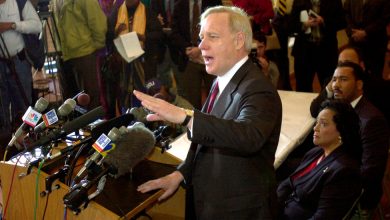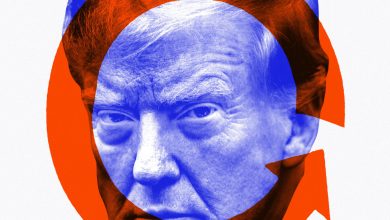This Statistic Could Be Distorting How We Think About Inflation

Preston Mui earned his doctorate in economics from the University of California, Berkeley, just last year, but he’s already making waves. This month he called out some of the biggest names in economics and policymaking in a blog post.
Mui wrote that economists and policymakers are making too much of one widely followed statistic: the unit labor cost, which is supposed to represent how much business has to spend for labor to produce one unit of output. Rising unit labor costs are said to contribute to inflation.
“Claims about inflation rooted in unit labor cost arguments are trivial, tautological or unsupported by the data; they are the emperor that has no clothes,” wrote Mui, who is a senior economist at Employ America, a research and advocacy organization fighting for full employment.
Mui linked to two prominent Harvard economists, Lawrence Summers and Jason Furman, who have expressed concern about high inflation, and named Christine Lagarde, the president of the European Central Bank, whose job is to drag Europe’s inflation rate back down. In a June 15 news conference, Lagarde cited unit labor costs five times. When asked why the central bank had revised its inflation expectations upward, she said, “The large part of it is the unit labor cost.”
Similarly, Jerome Powell, the chair of the Federal Reserve, cited unit labor costs in the footnote of a 2021 speech, writing that “ultimately” a persistent rise in unit labor costs adjusted for inflation “will put upward pressure on prices.”
On one level, the intent focus of Lagarde, Powell, the Harvard economists and others on unit labor costs is reasonable. It’s simple math: Unit labor costs rise when the amount that workers are paid goes up faster than their output does. That seems like a recipe for wage-driven inflation.
Mui acknowledges as much: In the textbook picture of the world, “Labor is used in production, high labor costs means production is costly, and costly production leads to higher prices.”
But Mui said the apparent causal link between unit labor costs and inflation is far weaker once you understand how the statistical sausage is made. It’s honest but crude. One of the two inputs into the calculation is inflation itself. So if inflation rises and nothing else changes, the unit labor cost will go up. By definition.
“In the postpandemic era, the increase in unit labor costs is almost entirely explained by growth in the deflator,” which is a measure of the price level, Mui wrote. So much for greedy workers.
Mui admitted that inflation isn’t the only factor in the calculation. Unit labor costs also rise if labor grows as a share of national income. That will happen if labor compensation (wages, salaries, benefits) grows faster than profits. That happened early in the pandemic, but it didn’t last.
“The labor share has since fallen and is essentially back to 2019 levels,” Mui wrote. “In historical context, it is hard to look at labor shares and conclude that compensation is too high relative to output.”
In any case, Mui wrote, it requires “some heroic assumptions” to connect the labor share of gross domestic product to what matters for inflation, namely the cost of hiring additional workers (or the marginal cost of labor, as economists call it). He wrote that it would be “not out of the historical norm” for the labor share to rise without causing inflation to rise.
I asked some of the people whom Mui called out for their reaction. Furman, who was the chair of President Barack Obama’s Council of Economic Advisers, said, “I’m certainly not saying there’s a causal arrow from unit labor costs to inflation. It goes both ways.” He also said that the measurement of unit labor costs may well be “imperfect.” But he said that “every measure of wage growth we have is running faster than before the pandemic” and that “productivity has been pretty crappy,” so it’s hard to imagine that rising unit labor costs aren’t at least partly responsible for high inflation.
Summers, through a spokeswoman, declined to comment for the record, as did the Federal Reserve and the European Central Bank. The E.C.B.’s website has speeches by Lagarde and others highlighting other causes of inflation, particularly wider profit margins.
When the pandemic hit, we saw wages and inflation go up. It’s hard to be sure whether wages drove up prices or prices drove up wages or some combination of the two occurred. As a senior economist for a pro-labor research and advocacy group, Mui is understandably in the camp of blaming inflation, not workers’ wage demands. At the very least, I think he has made a good case that rising unit labor costs aren’t prima facie evidence of wage-driven inflation.
Outlook: Chris Williamson
There was “a steepening downturn in global trade” in June, Chris Williamson, the chief business economist of S&P Global Market Intelligence in London, wrote on Friday. In manufacturing, new export orders fell in June for the 16th straight month. India, Thailand and the Philippines were the only countries with “noteworthy” gains in manufacturing exports, Williamson wrote. Services exports grew but not at May’s rapid pace. “The downturn in global machinery exports is particularly concerning, as such a decline typically signals reduced investment spending,” he wrote.
Quote of the Day
The golf links lie so near the mill
That almost every day
The laboring children can look out
And see the men at play
— Sarah Norcliffe Cleghorn, “The Golf Links Lie So Near the Mill” in “Portraits and Protests” (1917)



